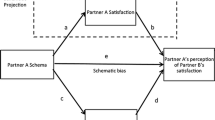Abstract
The sexual self-concept is an important component of the self-concept that researchers have rarely examined. The Women's Sexual Self-Concept Scale (WSSCS) is a 39-item measure designed to assess women's sexual self-concept. Women rate the extent to which various behaviors, cognitions, emotions, and adjectives describe their sexuality. In a study with 262 women, the measure was found to be both reliable and valid. Three factors were identified through exploratory Principal Components Analysis. Women rated themselves highest on the Reserved Approach subscale, followed by the Agentic Sexuality subscale, and the Negative Associations subscale. Compared to a stereotype of women's sexuality (obtained with a mixed-gender group of 444 participants), the women in the present study rated themselves higher on the Reserved Approach subscale and lower on the Negative Associations subscale. Group differences in women's sexual self-concepts were identified by past xinvolvement in romantic or sexual relationships, and current sexual involvement.
Similar content being viewed by others
References
Andersen, B. L., & Cyranowski, J. M. (1994). Women's sexual self-schema. Journal of Personality and Social Psychology, 67, 1079–1100.
Andersen, B. L., & Cyranowski, J. M. (1995). Women's sexuality: Behaviors, responses, and individual differences. Journal of Consulting and Clinical Psychology, 63, 891–906.
Andersen, B. L., Cyranowski, J. M., & Espindle, D. (1999). Men's sexual self-schema. Journal of Personality and Social Psychology, 76, 645–661.
Andersen, B. L., Woods, X. A., & Copeland, L. J. (1997). Sexual self-schema and sexual morbidity among gynecologic cancer survivors. Journal of Consulting and Clinical Psychology, 65, 221–229.
Andersen, B. L., Woods, X. A., & Cyranowski, J. M. (1994). Sexual self-schema as a possible predictor of sexual problems following cancer treatment. Canadian Journal of Human Sexuality, 3, 165–170.
Breakwell, G. M., & Millward, L. J. (1997). Sexual self-concept and sexual risk-taking. Journal of Adolescence, 20, 29–41.
Crosby, F., & Cordova, D. (1993). On the failure to see oneself as disadvantaged: Cognitive and emotional components. In M. A. Hogg & D. Abrams (Eds.), Group motivation: Social psychological perspectives (pp. 87–104). Hertfordshire, England: Harvester Wheatsheaf.
Crosby, F., Pufall, A., Snyder, R. C., O'Connell, M., & Whalen, P. (1989). The denial of personal disadvantage among you, me, and all the other ostriches. In M. Crawford & M. Gentry (Eds.), Gender and thought: Psychological perspectives (pp. 79–99). New York: Springer-Verlag.
Crowne, D. P., & Marlowe, D. (1960). A new scale of social desirability independent of psychopathology. Journal of Consulting Psychology, 24, 349–354.
Cyranowski, J. M., & Andersen, B. L. (1998). Schemas, sexuality, and romantic attachment. Journal of Personality and Social Psychology, 74, 1364–1379.
Cyranowski, J. M., & Andersen, B. L. (2000). Evidence of self-schematic cognitive processing in women with differing sexual self-views. Journal of Social and Clinical Psychology, 19, 519–543.
Fine, M. (1988). Sexuality, schooling, and adolescent females: The missing discourse of desire. Harvard Educational Review, 58, 29–53.
Markus, H., & Wurf, E. (1987). The dynamic self-concept: A social psychological perspective. Annual Review of Psychology, 38, 299–337.
McCormick, N. B. (1994). Sexual salvation: Affirming women's sexual rights and pleasures. Westport, CT: Praeger.
Snell, W. E. Jr., Fisher, T. D., & Miller, R. S. (1991). Development of the Sexual Awareness Questionnaire: Components, reliability, and validity. Annals of Sex Research, 4, 65–92.
Tolman, D. L., & Szalacha, L. A. (1999). Dimensions of desire: Bridging qualitative and quantitative methods in a study of female adolescent sexuality. Psychology of Women Quarterly, 23, 7–39.
Vance, C. S. (1992). Pleasure and danger: Toward a politics of sexuality. In C. S. Vance (Ed.), Pleasure and danger: Exploring female sexuality (pp. 1–27). London: Pandora Press.
Author information
Authors and Affiliations
Corresponding author
Rights and permissions
About this article
Cite this article
Vickberg, S.M.J., Deaux, K. Measuring the Dimensions of Women's Sexuality: The Women's Sexual Self-Concept Scale. Sex Roles 53, 361–369 (2005). https://doi.org/10.1007/s11199-005-6759-y
Issue Date:
DOI: https://doi.org/10.1007/s11199-005-6759-y




